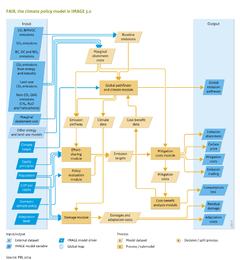Climate policy/Description: Difference between revisions
Jump to navigation
Jump to search
No edit summary |
Oostenrijr (talk | contribs) No edit summary |
||
| Line 1: | Line 1: | ||
{{ComponentDescriptionTemplate | {{ComponentDescriptionTemplate | ||
|Reference=Den Elzen et al., 2007; Van Vuuren et al., 2011a; Meinshausen et al., 2011b; Den Elzen et al., 2013; Hof et al., 2013; Roelfsema et al., 2014; Den Elzen et al., 2012a; Hof et al., 2012; Hof et al., 2008; Hof et al., 2010; De Bruin et al., 2009; Admiraal et al., | |Reference=Den Elzen et al., 2007; Van Vuuren et al., 2011a; Meinshausen et al., 2011b; Den Elzen et al., 2013; Hof et al., 2013; Roelfsema et al., 2014; Den Elzen et al., 2012a; Hof et al., 2012; Hof et al., 2008; Hof et al., 2010; De Bruin et al., 2009; Admiraal et al., 2016; Van den Berg et al. 2015; UNFCCC (2015b); Den Elzen et al., 2016; UNEP (2016); Rogelj et al., 2016; Den Elzen et al., 2015a; Kuramochi et al., 2016; Hof et al., 2016; | ||
|Description=FAIR consists of six linked modules as presented in the flowchart and described briefly below. | |Description=FAIR consists of six linked modules as presented in the flowchart and described briefly below. | ||
| Line 20: | Line 20: | ||
===Damage and Cost-Benefit Analysis modules=== | ===Damage and Cost-Benefit Analysis modules=== | ||
The Damage and Cost-Benefit Analysis modules calculate the consumption loss resulting from climate change damage, and compare these with the consumption losses of adaptation and mitigation costs ([[Hof et al., 2008]]; [[Hof et al., 2009|2009]]; [[Hof et al., 2010|2010]]; [[Admiraal et al., | The Damage and Cost-Benefit Analysis modules calculate the consumption loss resulting from climate change damage, and compare these with the consumption losses of adaptation and mitigation costs ([[Hof et al., 2008]]; [[Hof et al., 2009|2009]]; [[Hof et al., 2010|2010]]; [[Admiraal et al., 2016]]). Estimates of adaptation costs and residual damage (defined as the damage that remains after adaptation) are based on the [[AD RICE model]] ([[De Bruin et al., 2009]]), which are based on total damage projections made by the [[RICE model]]. Calibration of the regional adaptation cost functions is based on an assessment of each impact category described in the RICE model, using relevant studies and with expert judgement where necessary. The optimal level of adaptation can be calculated by the model, but may also be set to a non-optimal level by the user. | ||
===Estimation of consumption losses=== | ===Estimation of consumption losses=== | ||
Consumption losses due to mitigation, adaptation and climate change damage are estimated based on a simple [[Cobb-Douglas economic growth model|Cobb-Douglas economic growth model]]. Each region is calibrated separately to the exogenous GDP path. Damages, adaptation and abatement costs are subtracted from investment or consumption to determine either the direct replacement effect on consumption, or the indirect effect from replacing investments. | Consumption losses due to mitigation, adaptation and climate change damage are estimated based on a simple [[Cobb-Douglas economic growth model|Cobb-Douglas economic growth model]]. Each region is calibrated separately to the exogenous GDP path. Damages, adaptation and abatement costs are subtracted from investment or consumption to determine either the direct replacement effect on consumption, or the indirect effect from replacing investments. | ||
}} | }} | ||
Revision as of 16:40, 12 June 2017
Parts of Climate policy/Description
| Component is implemented in: |
|
| Related IMAGE components |
| Models/Databases |
| Key publications |
| References |
|
